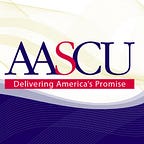5 Silver Linings to Get Campuses Through These Tough Times
Winston Churchill famously said, “Never let a good crisis go to waste.” For faculty, staff, and administrators at many of our AASCU campuses across the country, the COVID-19 crisis illuminated long-standing structural barriers and inequities and became a catalyst for significant, student-focused changes. Amid all the challenges and adversity, our institutions have identified “silver linings,” or important changes and lessons learned from the pandemic.
AASCU’s new report — Transformation Advisory Group: Lessons from the Field — captures honest and authentic reflections from AASCU’s Transformation Advisory Group (TAG), a peer-learning group of upper- to mid-level student success leaders from six AASCU member institutions. These reflections provide us with important takeaways — and a little hope — as we move into higher education’s “next normal.”
Silver Lining 1: Greater Attention to Fostering Social and Emotional Intelligence in the Workplace
In our previous brief, published December 2020, we highlighted that mid-level leaders must often rely on influence — rather than formal channels of supervision or authority — to work with colleagues across the institution to create positive changes for their students. When exhaustion and worry become so dominant as during the pandemic, the ability to influence decreases, and the need emerges to take particular care of those who take care of the students.
The pandemic emphasized the need for campuses to set and manage institutional priorities, especially given that the work related to equitable student success requires diverse insights, energy, compassion, and a culture that nourishes and revitalizes its employees on behalf of the students they serve.
Silver Lining 2: A Strengthened Sense of Purpose Amid Impossible Balancing Acts
When campuses are called to implement new and challenging ideas, mid-level leaders often pick up the baton, motivate the team, and guide the work toward the finish line. In institutions confronted with multiple pressures and priorities, mid-level leaders must execute impossible balancing acts. This compels them to develop authentic connections with their colleagues and find creative avenues to exercise their influence.
Especially for those invested in transforming their institutions for equitable student success, the pandemic shined a light on immense inequities in our society. This spurred renewed purpose and fortitude for mid-level leaders to work across silos to collaborate and create equity-centered change on their campuses.
Silver Lining 3: New Muscles Built Around Familiar Pain Points
In an ever-changing landscape, mid-level leaders discovered new and cultivated existing skills required to lead change from the middle. In a time without a script, mid-level leaders became stronger, smarter, and better able to manage their workload and that of those around them. This includes using data to guide decision-making (even when the trends prior to the pandemic no longer tell the full story), creating new communication channels, and driving innovations to keep classes on schedule and students in “seats.” Mid-level leaders experienced a crash course in finding and seizing opportunities to accelerate progress.
Silver Lining 4: Setting a Precedent for Change
Amid scarcity and exhaustion, public higher education institutions came together to achieve seemingly impossible student-centered changes, sometimes in a matter of weeks or even days.
With the possibility of large-scale, counter-cultural change now a reality, mid-level leaders have an opportunity to maintain and even accelerate the innovations necessary to better serve the students of today. In some cases, institutions elevated positions focused on student success to ensure that these leaders’ voices were consistently heard.
Silver Lining 5: Next-Level Attention to Equity
This last silver lining is the most important.
As our country begins to reckon with its long-standing history of systemic racism and inequities, we all have an opportunity to begin or continue our journeys to become equity-minded practitioners. This work begins on a personal level and requires us to learn, uncover, and grapple with our own experiences and perspectives. (Read more about driving equity-minded change on campuses in From Equity Talk to Equity Walk: Expanding Practitioner Knowledge for Racial Justice in Higher Education.)
In a time when transformation is necessary for survival, AASCU institutions stand at the forefront and must be prepared to make the changes necessary to ensure their Black, Latinx, Indigenous, and low-income students have equal opportunities to succeed.
TAG members modeled how a personal commitment to equity can translate to professional and institutional gains. They called for institutions to listen more closely to traditionally marginalized students, examine which students are succeeding and why, and focus more intentionally on equitable practices. They also provided space for colleagues to learn, explore, grow, and come together to define a more equitable “next normal.”
Mid-level leaders, who sit at the center of complex change efforts at an institution, have been and will continue to be crucial in these efforts. With new tools in their belts and a commitment to defining a more equitable future at our institutions, mid-level leaders are more equipped than ever before to lead vital changes and influence others.
The reflections and lessons learned from our TAG members may alter the way you think about your institution; its mid-level leaders; and how to achieve equity for students, faculty, and staff. Read the full brief or view our other publications for more insights.
This post was written by Melissa Welker, director of AASCU’s Frontier Set.
